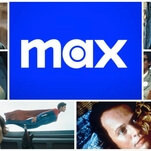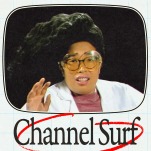The special features on the complete Get A Life DVD collection include the usual goodies—commentary tracks from creator David Mirkin (co-creator Adam Resnick and star Chris Elliott are conspicuously absent), featurettes in which comedy heavyweights such as Judd Apatow and James L. Brooks wax rhapsodic on their love for the cult classic program, what have you—with one notable exception. When putting together the collection, distributors Shout! Factory wrangled professional psychotherapist Dr. Wendy Walsh to provide a commentary of her own on select episodes. As 30-year-old paperboy Chris Peterson (Elliott) barrels through 35 episodes’ worth of zany, sitcom-ready misadventures, Dr. Walsh pins everything from delusions of grandeur to borderline-personality disorder on the character. He’s an analyst’s wet dream, a patient with a litany of billable mental issues lengthy enough to finance a second home. The most illuminating approach to Get A Life and to the hurricane of psychopathy that is Chris Peterson is not criticism: it’s diagnosis.
The Get A Life pilot premiered on Fox on September 23, 1990, to a reception marked by confusion, alienation, and worry. Network executives detested the show, certain that its off-putting protagonist would drive viewers away with his mile-wide streak of self-absorption. But with two-and-a-half decades in the rearview, Elliott’s deranged comic creation looks more like the vanguard of a bold and modern mode of humor. With his flagrant disregard not only for the people around him but for the boundaries of reason itself, Chris Peterson blazed a trail for a movement that’s brought audiences dozens of millennial gems. It couldn’t push Get A Life past the two-season mark, but the show’s overall sensibility of unrepentant dickishness has propelled everyone from Andy Samberg to Tom Green to icon status among comedy nerds, and made the pop-cultural landscape a more fascinating and dangerous playground for the rest of us.
Get A Life’s Chris lives entirely within his own head, a happy place where he’s practically the mayor of the town. In his own estimation, there’s nobody more beloved, incurably charming, handsome, or wise than Chris Peterson. He enters every situation with a wholly unearned sense of confidence and self-assurance; in the series highlight “Drivers License,” Chris greets the cop administering his road test with a cheery, “So, how’d you get stuck with this sissy detail?” He doesn’t let his discomfiting combination of premature male-pattern baldness and babyish face deter him from putting the moves on women far out of his league, either. His dimness extends to epic proportions, leading him to open hatch doors on aloft airplanes and mistake paper for food. And yet Chris carries himself with a nearly cartoonish degree of aplomb.
He’s an odd study in contrasts, defined both by the guilelessness of arrested development and a pathological drive to cause havoc everywhere he goes. It’s clear that he loves his long-suffering parents, the perpetually bathrobe-clad Gladys and Fred (Elinor Donahue and Elliott’s real-life father, Bob). And yet, Chris takes a perverse pleasure in overdrawing on his mother’s sympathy and straight-up antagonizing his easily angered father. (Picture the relationship between Red and Eric Foreman, but with the possibility of homicide very much on the table.) But any therapist with enough self-loathing to take on Chris would do well to begin their case study with “Roots,” an episode that finds the manchild latching onto the belief that he’s been adopted and his parents have gotten extensive plastic surgery to look more like him, and consequently setting out in search of his “real” parents. That quest leads him to impose on a kindly Amish couple who welcome Chris in with good Christian generosity, unaware that at least in terms of basic manners, Chris might just be the antichrist. He methodically wears down their goodwill, starting by mocking their ascetic lifestyle (“Hey, there’s this new thing called color! Ever heard of it?”) and ratcheting the rudeness factor up and up until the simple God-fearing couple considers cold-blooded murder.
This is pretty much Chris’ modus operandi, pushing the patience of everyone unlucky enough to cross his path until it breaks. The genius of Get A Life lies in its subtle negotiation between its kindly sitcom past and a vicious transgressive present; the comic shenanigans that fill each episode could’ve been nicked from the years of sitcom tradition that preceded Get A Life, but the glee with which Chris perverts these stock storylines heralds an fresh ethic of television production. Get A Life places Chris the boorish bull in the finest of china shops, the bright friendly artificiality of the multi-camera sitcom. The show is a clear product of the ’90s—from the R.E.M. theme song to the slacker’s fantasy of living at home with his parents forever to the grating laugh track that drives home every punch line—and yet it genuflects to a legacy of TV comedy while spawning one all its own.
A couple of promising young men named Bob Odenkirk and Charlie Kaufman joined the writing staff in season two and brought their talents for genre deconstruction with them, spawning episodes that annihilated the all’s-well-that-ends-well tidiness native to sitcoms. In Odenkirk’s first go, “Larry On The Loose,” Chris convinces his best friend to leave his wife, who also happens to be Chris’ sworn enemy. By the end of the half-hour, Larry has not returned for a tearful embrace with his spouse. Chris hasn’t learned a valuable lesson about interfering in other people’s lives. The show simply continues moving forward.
Chris Peterson’s DNA can be found all over modern comedy, both on TV and at the movies. The potent combination of naïveté and brash disconnect from reality has paid dividends for some of the premier comic talents earning cult adoration today; without Chris, there would be no Freddy Got Fingered, which shares with the character a penchant for destruction and a fraught father-son dynamic. (And just as with the prematurely cancelled Get A Life, those who mourned Freddy Got Fingered’s lack of commercial success would be few and far between, yet passionately vocal.) Though It’s Always Sunny In Philadelphia swaps out Chris’ core innocence for hardcore misanthropy, the program owes a debt of gratitude to Get A Life as well, Chris’ happy mayhem having kicked open the door for The Gang’s unself-aware douchebaggery. Chris’ disciples have popped up as recently as HBO’s batty sports mockumentary 7 Days In Hell: Andy Samberg’s tennis champ Aaron Williams shrugs off the cumbersome burdens of sympathy and decency, blowing past Chris’ pseudo-sweetness directly into “asshole” territory (John McEnroe’s words, not mine).
In one of the show’s most forwardly postmodern flourishes, Chris dies at the conclusion of exactly 12 episodes and returns unscathed in the next installment with no explanation provided whatsoever. In this respect, Mirkin, Resnick, and Elliott foretold their own fate with eerie prescience. Fox cut down Get A Life in its prime, and in doing so, made a martyr out of America’s favorite psychopath. Chris Peterson’s legacy endures today not because Get A Life has attained the graven-object stature of an Arrested Development or a Party Down—it remains something of a secret password between diehard comedy fans. The unhinged paperboy next door found eternal life instead in his spiritual successors, a legion of self-absorbed, hostile, or outright cruel lunatics thoroughly convinced that they’re widely cherished. The sweetest irony of all? In our world, they are, and can never know it.








































